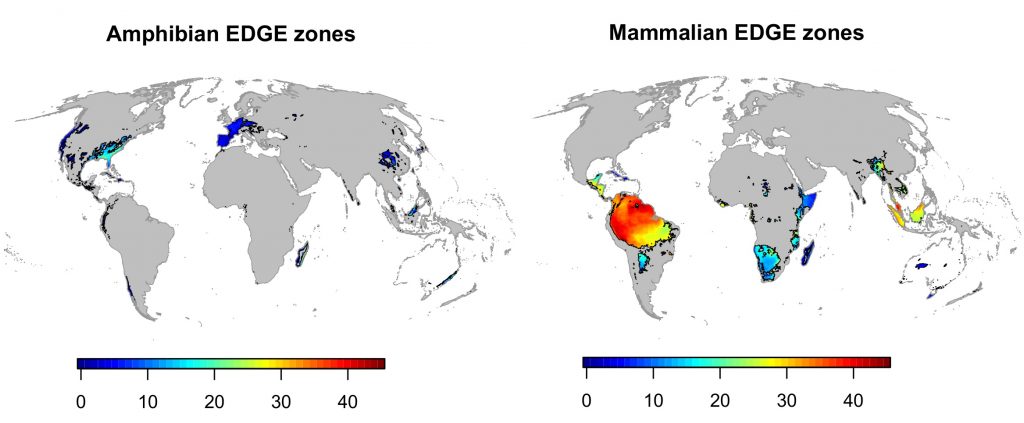This 18 September 2018 video from Singapore says about itself:
Sandshrew the Sunda Pangolin released back to the wild
Sunda pangolins like Sandshrew – named after a Pokemon character – will receive better protection in future with the launch of the Sunda Pangolin National Conservation Strategy and Action Plan on Tuesday (Sept 18).
Read more here.
From Wildlife Extra:
World’s rarest and most extraordinary species mapped for the first time
Sunda pangolin occurs in Southeast Asia and is threatened by illegal poaching for its meat and for its scales – Used in traditional medicine. Courtesy of Carnivore and Pangolin Conservation Programme
EDGE species added to the map
May 2013. The black-and-white ruffed lemur, Mexican salamander and Sunda pangolin all feature on the first map of the world’s most unique and threatened mammals and amphibians, created by the Zoological Society of London(ZSL).Scientists pinpointed areas of the world where Evolutionarily Distinct and Globally Endangered (EDGE) mammals and amphibians occur. Regions containing the highest concentrations of these species are highlighted as global conservation priorities.
Different regions for different groups
The map reveals that high priority conservation areas for mammals and amphibians are different, reflecting the varied evolutionary histories and threats facing the two groups. For mammals, management efforts are best focused in Southeast Asia, southern Africa and Madagascar. For amphibians, central and southern America are highlighted as priorities.Very few protected areas
Professor Jonathan Baillie, ZSL’s Director of Conservation says: “The results of the mapping exercise are alarming. Currently only five percent of the areas we’ve identified as priorities for EDGE mammals and 15 percent of the EDGE amphibian areas are protected.“These areas highlighted should all be global conservation priorities because they contain species that are not only highly threatened but also unique in the way they look, live and behave. These new maps will inform the development of larger-scale work to help secure the future of some of the most remarkable species on Earth,” Professor Baillie added.
The Mexican salamander, or axolotl, is critically endangered due to urbanization, polluted waters, and the introduction of non-native fish which eat the axolotl’s young. Scroll down to see the map of EDGE amphibians.
Black-and-white ruffed lemur & Sunda pangolin
Madagascar’s black-and-white ruffed lemur is the largest lemur in the world and is threatened by hunting and the loss of its forest habitat to logging, mining and cutting and burning for agriculture. The Sunda pangolin, also known as the scaly anteater, occurs in Southeast Asia and is threatened by illegal poaching for its meat which is a culinary delicacy, as well as its scales which are thought to have high medicinal value. Other mammal species occurring in priority areas include the black rhino and western lowland gorilla.Amphibians
Amphibians are facing a terrifying rate of extinction making them the most threatened vertebrates in the world. The Mexican salamander, or axolotl, is critically endangered due to urbanization, polluted waters, and the introduction of non-native fish which eat the axolotl’s young. With the aid of the global map of EDGE amphibians, it will now be possible to concentrate efforts in countries such as, Mexico, Costa Rica and Guatemala where the most distinct and threatened species are found.Dr. Kamran Safi, lead author of the paper from the Max Planck Institute for Ornithology says: “This is the first global map to take into account species’ uniqueness as well as threat. Now that we’ve identified EDGE priority areas for mammals and amphibians we can more effectively continue to ensure their protection.”
It is critical that conservationists prioritise the allocation of limited resources for the best conservation outcomes. ZSL’s EDGE of Existence programme has already launched targeted conservation projects for more than 40 EDGE species around the world.
The research paper is published in PLOS ONE.

Related articles
- Most distinct species mapped (bbc.co.uk)
- Helping amphibians, reptiles in your own backyard (dearkitty1.wordpress.com)
- European shrub threatens US frogs (bbc.co.uk)
- Reptiles and Amphibians (sotinpc.wordpress.com)
- Axolotl (herpetology101.wordpress.com)





Reblogged this on Rashid's Blog.
LikeLike
Thanks for reblogging, Rashid!
LikeLike
my pleasure
LikeLike
thanks for sharing! 🙂
LikeLike
🙂
LikeLike
Lemurs are an order of primates that live exclusively on the island of Madagascar. Their name comes from Roman mythology, referring to ghosts – likely due to the nocturnal habits and large, reflective eyes of some of the species. While sometimes mistaken for monkeys, they are a separate branch of primates that began to develop into their own suborder “Strepsirrhini” some 65 million years ago. The uniqueness of the species comes from the fact they evolved over many millennia cut off from the rest of the world on a massive island (Madagascar is the fourth largest island in the world.) Most lemur species are gregarious and live in groups with several individuals. Most species have divergent digits and fingernails rather than claws. Lemurs range from being very small (1.1 ounce or 30 grams) to some of the large species the size of an average monkey, about 20 pounds. Lemurs are generally plant eaters, although some species will supplement their diets with insects and fruit. Due to deforestation of their island home (nearly all of the old growth forests in Madagascar are now gone or are only a small fraction of what they once were) most of the species of lemur are endangered or near threatened. Many conservation groups are fighting to preserve the few remaining areas where the lemurs live, most of these being in nationally designated parks.
LikeLike
Pingback: Very Inspiring Blogger Award, thank you Khalil! | Dear Kitty. Some blog
Pingback: Reptiles, amphibians and fire | Dear Kitty. Some blog
Pingback: Shine On Award, thanks Shaun and Tazein! | Dear Kitty. Some blog
Pingback: Saving reptiles and amphibians | Dear Kitty. Some blog
Pingback: Save pangolins, video | Dear Kitty. Some blog